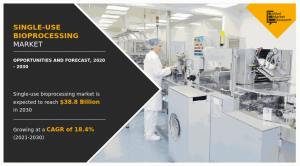
Single-use bioprocessing is a technology used in biopharmaceutical manufacturing that involves the use of disposable components, such as plastic bags, tubing, and filters, rather than traditional stainless steel equipment, which is typically cleaned and sterilized for reuse. The global single-use bioprocessing market size was valued at $7.0 billion in 2020, and is projected to reach $38.8 billion by 2030, growing at a CAGR of 18.4% from 2021 to 2030.
Single-use bioprocessing offers several advantages over traditional bioprocessing, including faster setup times, reduced cleaning and validation requirements, and increased flexibility for scaling up or down production. Additionally, the use of disposable components can minimize the risk of cross-contamination, which is particularly important when producing biologics, such as vaccines and monoclonal antibodies, that require a high degree of purity.
Single-use bioprocessing has become increasingly popular in recent years, and is now widely used in both clinical and commercial manufacturing of biologics. While there are some challenges associated with single-use bioprocessing, such as the potential for leachables and extractables from plastic materials, overall it offers a number of advantages that make it an attractive option for biopharmaceutical manufacturers.
Single-use processes in the pharmaceutical industry are those that utilize disposable components, such as plastic bags, filters, tubing, and connectors, instead of traditional stainless steel equipment that needs to be cleaned and sterilized for reuse. These disposable components are typically used for a single batch or production run, and then discarded.
Single-use processes are increasingly being used in the pharmaceutical industry for a variety of applications, including:
- Bioprocessing: Single-use bioprocessing systems are widely used in the manufacturing of biologics, such as monoclonal antibodies and vaccines, due to the flexibility, cost-effectiveness, and reduced risk of cross-contamination they offer.
- Fill-Finish operations: Single-use systems are used in the final stages of drug production, including the filling, capping, and labeling of vials, syringes, and cartridges.
- Downstream processing: Single-use systems are also used in the purification of biologics and other drugs, including chromatography and filtration steps.
- Clinical and laboratory operations: Single-use systems are used in research and development, clinical trials, and other laboratory operations, including cell culture, media preparation, and diagnostic testing.
Some of the benefits of single-use processes in the pharmaceutical industry include reduced cleaning and validation requirements, faster turnaround times, and increased flexibility and scalability. However, there are also some challenges associated with single-use systems, such as the potential for leachables and extractables from plastic materials, which can affect product quality and patient safety.
Download Free Sample PDF:
https://www.alliedmarketresearch.com/request-sample/2359
Bioprocessing is a term used to describe the use of living cells or their components to produce drugs, vaccines, and other biologic products. There are several types of bioprocessing, including:
- Upstream Processing: This involves the cultivation and manipulation of living cells or microorganisms in bioreactors or fermenters to produce the desired product. Upstream processing typically includes steps such as cell culture, cell line development, and media preparation.
- Downstream Processing: This involves the purification and isolation of the desired product from the complex mixture of proteins, nucleic acids, and other cellular components produced in upstream processing. Downstream processing typically includes steps such as filtration, chromatography, and centrifugation.
- Formulation and Fill-Finish: This involves the final steps in drug production, including the formulation of the purified product into a stable dosage form, such as a vial or syringe, and the filling and packaging of the final product.
- Analytical Testing: This involves the testing of the product at various stages of production to ensure its safety, purity, and potency.
- Process Development: This involves the optimization of the bioprocessing steps to improve yield, quality, and cost-effectiveness.
- Continuous Bioprocessing: This is a newer approach that involves the continuous production and purification of biologics, rather than the traditional batch processing approach.
Each of these types of bioprocessing is critical to the production of biologic drugs, vaccines, and other products. They all involve complex and highly regulated processes that require extensive knowledge of the biology of the cell lines or microorganisms being used, as well as the engineering principles underlying the bioprocessing equipment and techniques.
Bioprocessing technologies are a set of techniques and tools used to manipulate biological materials and organisms to produce drugs, vaccines, and other biologic products. Some of the key bioprocessing technologies include:
- Cell culture: This is a technique used to grow living cells in a controlled environment, typically in bioreactors or flasks, and is an essential part of bioprocessing for the production of proteins, monoclonal antibodies, and other biologics.
- Fermentation: This is a process in which microorganisms, such as bacteria or yeast, are used to produce a desired product, such as insulin or ethanol, through the process of anaerobic metabolism.
- Chromatography: This is a technique used to separate and purify proteins and other biological molecules based on their physical and chemical properties, such as charge, size, and affinity.
- Filtration: This is a process used to separate particles from a liquid or gas using a physical barrier, typically a membrane or filter.
- Centrifugation: This is a technique used to separate particles based on their density and size using a high-speed spinning rotor.
- Process automation: This involves the use of software and hardware to control and monitor bioprocessing operations, such as temperature, pH, and nutrient levels, to ensure consistent and efficient production.
- Single-use bioprocessing: This involves the use of disposable components, such as plastic bags, filters, and tubing, instead of traditional stainless steel equipment, to reduce cleaning and validation requirements, and minimize the risk of cross-contamination.
Bioprocessing technologies are constantly evolving as new biologic products are developed and as technology advances. These technologies are essential to the production of safe and effective biologic drugs and are critical to the success of the biopharmaceutical industry.
Contact:
David Correa
USA/Canada (Toll Free): +1-800-792-5285, +1-503-894-6022

